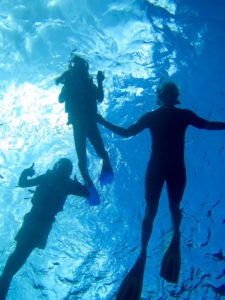 So, you’ve decided to travel with your kids and thought you’d have them learn from the great big world around them and homeschool as you go. Great! Your kids are in for a rich, learning adventure. Know up front that you can totally do this!
So, you’ve decided to travel with your kids and thought you’d have them learn from the great big world around them and homeschool as you go. Great! Your kids are in for a rich, learning adventure. Know up front that you can totally do this!
When we first did it, I researched homeschooling and quickly became overwhelmed. There is so much information out there! This is why I want to simplify the process for you by showing you how we did it in five steps. Ready? Here we go!
#1 Get Inspired
If you’re wondering if you’re doing the right thing, particularly if you’re an American, check out the following TED talks by British educator, Sir Ken Robinson (about 20 minutes each).
#2 Research How You Will Teach
There are a plethora of books and websites on homeschooling. To prevent massive overwhelm, I chose one book and one website, and between them, I learned everything I needed to know (and do!). The book was The First Year of Homeschooling your Child and the website was A to Z Homeschool.
The two most important things I learned from the book is that there are many homeschooling methods (such as Charlotte Mason, Unschooling, or Unit Studies), and many different styles in which kids learn best (such as visual or physical). Knowing that our son practically vomits at the sight of a worksheet, for example, we knew that he learned best when moving his body, and from real world interactions and interactive computer games, and we adjusted his learning accordingly. Know that it may take trial and error to figure out what method and style work best for your child and family. Give yourself time.
Know, also, that in the U.S., some public and private schools offer a homeschooling option. If you decide to go with such an option, you may be able to skip step #3 below. Check with that school and/or district to verify.
#3 Register to Homeschool Legally
Laws around homeschooling vary depending on your home country, or in the U.S., your home state. For laws for your U.S. state, see this link.
Legal Requirements for California
As we registered through California, I’ll list current legal requirements for homeschooling through that state, which are as follows. Note: You DO NOT need to register any child who is under the age of six.
- Have a name and address for your own “private school.” (Ours is World Adventures Academy.)
- Instruct in English. (At least 50% English for gifted children. Others: English only.)
- File a Private School Affidavit online between Oct. 1 and 15 each year. (Mid-year if starting mid-year.) This registers your homeschool as a “private school” in California. Step-by-step instructions are here, including a Sample Form and link to the filing site.
- Keep the following items on file for each child, even though you will likely never be asked to show these.
- Attendance Record – Simple record of the school year showing any days student is absent from education. (Keep in mind that kids typically learn every day!)
- Diploma of at least one parent for their highest educational achievement.
- Courses of study offered by the institution. (Note: You are never required to show any actual curriculum you use.)
- Two forms filled out for health & safety reasons. The first required record is the California School Immunization Record (Form PM286B), often called the “blue card.” This is for the homeschooling parents to fill out; it can also be a child’s regular yellow vaccination record. The second is the Report of Health Exam for School Entry (PM171A) or Waiver (PM171B), which is for a health care practitioner/doctor to fill out. For more information on this legal requirement, please see this link.
- Private School Affidavit you filed.
Courses of Study Legally Required (grades 1 – 6)
This information comes from California Education website. You’re required to cover these subjects, but how you do it is up to you. Calculating exchange of currency, for example, counts as math!
- (a) English, including knowledge of, and appreciation for literature and the language, as well as the skills of speaking, reading, listening, spelling, handwriting, and composition.
- (b) Mathematics, including concepts, operational skills, and problem solving.
- (c) Social sciences, drawing upon the disciplines of anthropology, economics, geography, history, political science, psychology, and sociology, designed to fit the maturity of the pupils. Instruction shall provide a foundation for understanding the history, resources, development, and government of California and the United States of America; the development of the American economic system including the role of the entrepreneur and labor; man’s relations to his human and natural environment; eastern and western cultures and civilizations; contemporary issues; and the wise use of natural resources.
- (d) Science, including the biological and physical aspects, with emphasis on the processes of experimental inquiry and on man’s place in ecological systems.
- (e) Fine arts, including instruction in the subjects of art and music, aimed at the development of aesthetic appreciation and the skills of creative expression.
- (f) Health, including instruction in the principles and practices of individual, family, and community health.
- (g) Physical education, with emphasis upon the physical activities for the pupils that may be conducive to health and vigor of body and mind, for a total period of time of not less than 200 minutes each 10 school days, exclusive of recesses and the lunch period.
#4 Gather the Resources You Need
Know that I never bothered with curriculum or workbooks. First, both the book and multiple websites warned not to waste money on them. Also, I found numerous educational resources on the Internet, from math worksheets to interactive educational programs, for either free or at very little cost. Because we traveled light, we needed to get information through our iPads and computers anyway, which also happened to suit our son’s learning style better.
Here’s our list of the online educational resources we used, which includes a suggested course of study for each grade level.
#5 Go For It!

A good day in the classroom!
When we weren’t actively on the road, we aimed for 3 hours per day, 3 days per week of homeschooling, and focused on Reading, Writing, and Math (the fundamentals). For everything else (science, social studies, health, etc.), we just grabbed lessons from our day to day experiences, including visits to museums and local markets, and followed our kids’ interests (Julien wanted to learn about the stars, for example). We also let our kids watch learning videos, like the Magic School Bus or Crash Course, both on YouTube.
I also kept on hand three documents:
- A one-sheet attendance record, required by the state – I only marked our son as “absent” if he was sick; or truly on vacation from learning, which was rare. Kids learn pretty much every day!
- Lesson Plans – This was just a bulleted “wish list” of what I wanted Julien to learn per subject during that academic year, taken from a suggested course of study, Julien’s own interests, and what I know about what our son can (and wants!) to do. It’s also a state requirement to have this on hand.
- Education Log – Every quarter, I take notes on what Julien actually did or learned per subject, for my own records.
Bonus: Get Connected
If you are in a travel location long enough, I recommend getting kids into local activities and classes, or community events, in addition to the usual destination exploration. That’s where some of the real learning happens anyway! And it’s a great way for kids and families to get involved with locals and the community. I also recommend connecting with other worldschoolers, wherever you find them. One Facebook group I love is Worlsdschoolers, but you can find many similar groups online. It helps to connect and share experiences with like minded people!
This blog post, including photos, is copyrighted (c) 2017 by Cindy Bailey Giauque and is an original publication of www.worldadventuresacademy.com. Please join us, My Little Vagabonds, on Twitter and Facebook. Happy travels!

Thank you for demystifying this process, Cindy. So helpful!
Thanks, Jessica!
Thank you, the whole idea of actually doing this is pretty daunting and I wasn’t really sure on where to start, you have definitely helped me to get an idea, I have just ordered the book that you recommended, so thank you.
It IS daunting to get started! There is so much information out there it’s hard to know where to start. So glad this helped you get going. All the best to you!